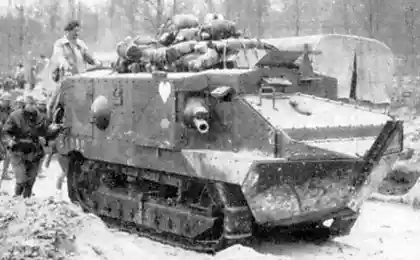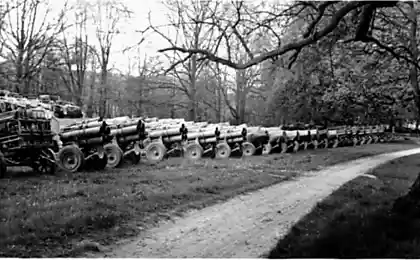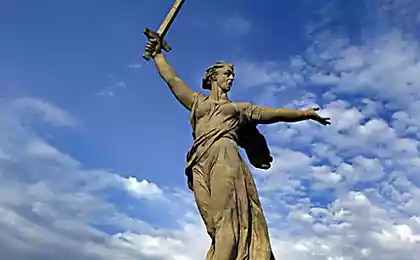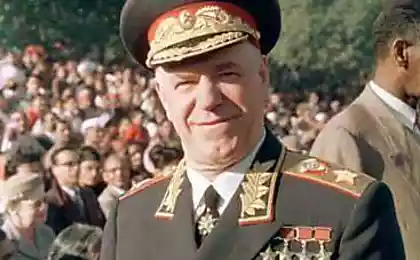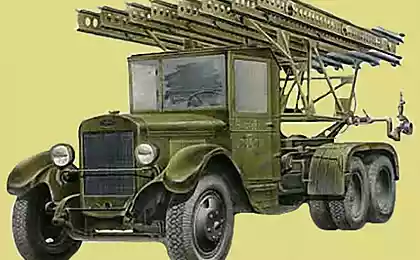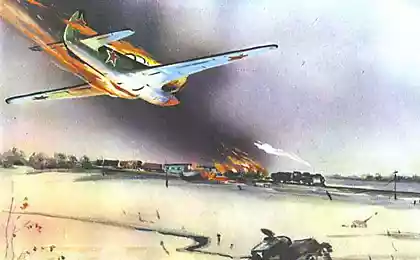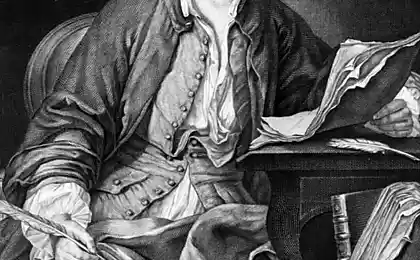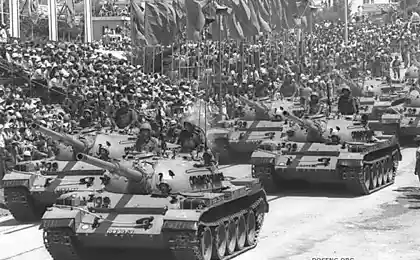1171
From the history of artillery
Stumbled today surf tyrnete a very interesting article. Despite the fact that I'm interested in history, weapons and weapons of history pattern was a bit broken, in the positive sense of the word, so please Reading ...
12 photo.
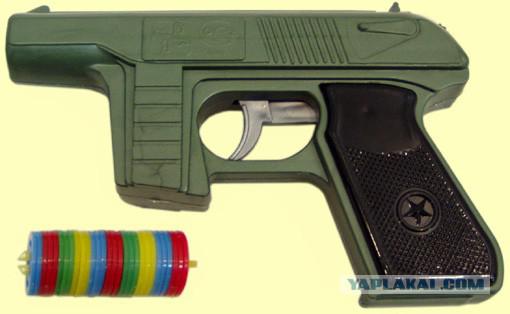
Writes aeromamont
About discs.
I have long wanted to write about these exhibits of the Museum of Artillery in St. Petersburg. On the one hand, they pay attention to almost all visitors to the museum, it was too pretentious they look. On the other hand, the information dedicated to these systems are not very plentiful, exhausted explanatory plaque and posters in the museum. I also wanted to talk about in more detail as the original artillery artifacts.
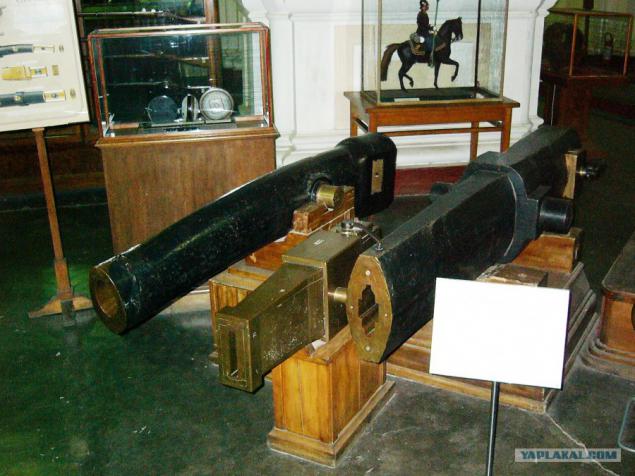
To my surprise, the search for information on the Internet that gave little. Almost everything that was possible to find, was reduced to an explanatory label in the museum, in the best case, repeating its volume. The second source of information for online publications served as a series of articles of prof. Malikov VG dedicated to the history of artillery, were published in the 80s in "Technique of youth." There was a separate article devoted diskometam where in accessible form briefly describes these devices.
Find out something more detail is extremely difficult. All that is in the network is usually limited to these two sources. But I have never found the answer to the question, why did invent such exotica, if you could just take a gun with a rifled barrel, had already long been known.
So I began to dig further. I want to share the results with you in this post.
By the middle of the XIX century smoothbore artillery reached the limit of their capabilities. Further increase mobility, rate, range and accuracy of guns was possible only after a qualitative leap of technology. One such breakthrough was the transition to a rifled barrel. Now it is a truism, but the gunners of the time it was not so obvious. The fact that the first rifled cannon, despite the increase in shooting accuracy and range have numerous disadvantages and for the aggregate characteristics often been unsatisfactory.
First of all, the cost and complexity of manufacturing rifled barrels significantly higher than smooth. A persistence of these trunks, by contrast, declined sharply. The first rifled barrels produced by upgrading smoothbore, by applying the rifling in the barrel.
It quickly became clear that the cast for making rifled barrels is not suitable (insufficient strength at increased pressure of powder gases in the barrel compared to the guns of) and basically reworking touched bronze cannon. However, during the operation revealed the shortcomings of such modernization. Rifling, made in bronze gun barrel, quickly fade under the influence of propellant gases and friction forces. As a result of the upgraded guns again turned into shotguns, but slightly larger caliber, which in turn led to a decrease in the wall of the barrel and, as a consequence, to reduce the strength of the gun. For these reasons, in the end, had to abandon it would seem a promising way of modernizing obsolete guns.
In addition, the instruments remained dulnozaryadnymi and rifled guns firing rate rather decreased. Shells shells for these guns were equipped with lugs. That such:

These protrusions when charging is combined with rifling and scored projectile into the barrel. Between the projectile and the walls of the bore is a gap, leading to a breakthrough propellant gases during firing, which reduced its capacity. In addition, due to these gaps, the projectile got oscillatory motion of a random nature, which reduces the accuracy of fire, nullifying the benefits of rifles. Not to mention the fact that the case of jamming of shells in the barrel during firing.
Offers another polygonal system. Englishman Whitworth, for example, offered to make the bore in the form of a twisted hexagon projectile was a twisted pyramid. Accuracy and range by testing impressive. Equally impressive artillery intricate method of loading a gun. You could show off at the landfill, gently inserting a polygonal projectile in the gun barrel, but in combat such acrobatics was hardly possible. The cost and complexity of such systems is also not allowed to impress customers.
It is necessary to add to the shortcomings of rifled guns of the time small relative length of the barrel.
As we see, in itself rifled barrel while still possessed overwhelming advantages over smooth. Only when there were steel barrel with rifling progressive slope, reliable closures guns, ammunition belts with guides, new gunpowder committed carriages, artillery really moved to a qualitatively new level, poistene becoming the god of war.
But before this was still far off. The way for further development of artillery torili in many different directions. In these conditions, and some appeared guns, shooting discoid shells. They were preceded by the use of so-called regulated shells in conventional smoothbore gun.
In the first half of XIX century. leading countries engaged in yet another improvement of their artillery, widely cycling theoretical research of internal and external ballistics. On this subject there is a good article by Poddubniy, a piece that let me quote:
Thus was established the inevitable deviations from the calculated trajectory of the nucleus, which arises as a consequence of uneven friction kernel of the wall of the bore and the eccentricity of his own. As a result, core, leaving the bore, acquire rotation in a random direction. And though, of course rotation of the nucleus gave it stability in flight, unpredictability rotation direction leads to the practical impossibility of determining the actual trajectory of the projectile.
Remove core eccentricity due to technological difficulties it was impossible. Then the German physicist Magnus in 1852 offered to pay one of the drawbacks of the nuclei in their favor. In his writings, he found that on a body rotating around its flow of gas or liquid, acting shear force in the direction where the peripheral speed of the body and the linear flow are the same. And if so, why not make a kernel with more eccentric and predetermined direction of rotation in the desired direction, and thereby improve the accuracy of the calculated trajectory and its flight range.
At the suggestion was made Magnus party spherical garnet with significant eccentricity. To determine the "light" pole, they were placed in a bath with mercury and by the forces of gravity, the "light" pole turned out above. Next to the "easy" pole smeared with a special mark.
Conducted by experienced such firing grenades showed the correctness of theoretical calculations of Magnus. When loading of the gun "easy" pole down grenade after getting the shot rotation from the bottom up and firing range increased to 1300 meters. And in the reverse position grenades - "light" side up, garnet obtained by rotating the top down and fell to the firing range of 500 meters.
But despite the successful experiments further experiments did not get. The main reason for which were rejected by the gunners shells Magnus became greater complexity loading guns such bombs. It was virtually impossible to properly orient a long barrel guns dulnozaryadnyh. In view of these circumstances gunners turned their attention to the flattened and disk-shaped projectiles.
A. Nilus wrote in his "History of the artillery materiel":
The result of these experiments was the adoption of regulated grenades only in Prussia and Saxony.
Successful results when shooting regulate grenades could happen in Prussia, thanks to the excellent training and discipline of the Prussian gunner and generally careful and judicious his duties by all ranks of the Prussian artillery.
They are unlikely, however, could be preserved in the actual field battle. The use of eccentric regulated grenades and bombs to the firing of mortars and howitzers soon possible in the siege and land war, where the servants closed from serfdom fire. In the field, at the slightest confusion workers, the results of firing grenades regulate may be worse than unregulated. These considerations have prevented the spread of fire grenades regulate other artillery.
And here is one more step remains before suggests solutions. To use the above Magnus and not to suffer with the orientation of the round nucleus in the gun barrel, you need to make the projectile flattened laterally, and make him twist in the barrel from the bottom up with the shot. Then no need to search for "black light", and the axis of rotation of the projectile is always oriented correctly.
One of the first to hit upon the idea of Russian artillery captain AA Shlipenbah Belgian artillery Pyuyt Englishman Vulkomb. They offered Banded shells with holes for eccentricity. The main advantage of these shells they have seen an increase in the lateral load and high breakdown strength projectiles especially on armored warships, then just appeared.
I want to emphasize this detail - primarily interested in the increase of their armor-piercing projectiles compared with round nuclei. Originally this problem have tried to solve by simply increasing the caliber of guns, but it led to an unacceptable increase in the weight of the guns themselves. And here was an attempt to solve the problem elegantly.
However, these shells are disadvantageous all eccentric shells.
Correct these deficiencies were designed to study St. Paul Roberto, published in 1857, which describes the ways in which flattened shells can get the correct rotation. Some of these methods have been implemented and Russian inventors, and the result can be seen on the first photo.
Methods of these are illustrated in the poster, established alongside these instruments in the museum
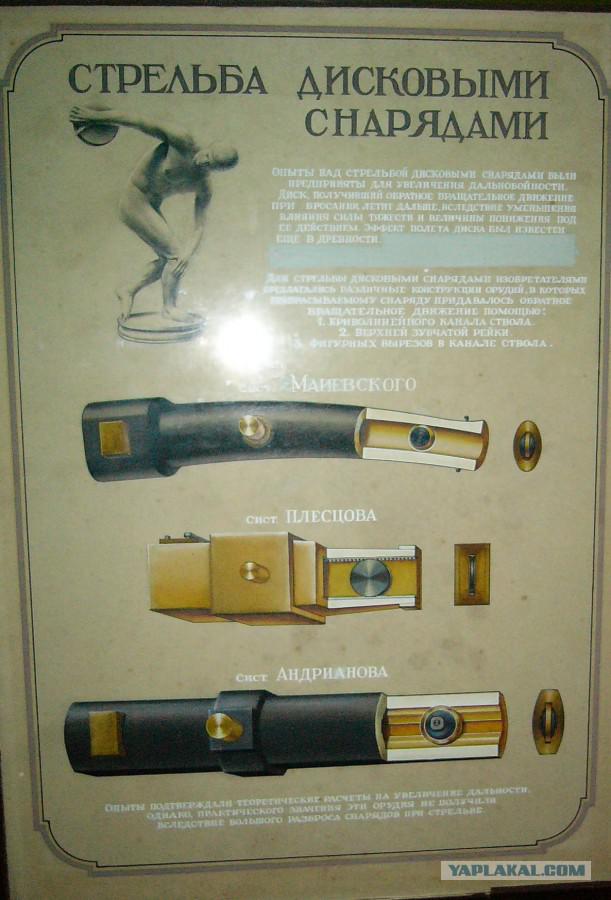
The top figure shows a poster of weapon prof. Maievsky NV, he proposed in 1868
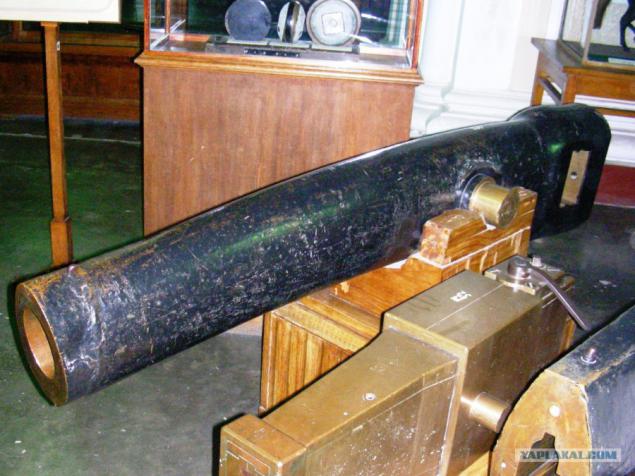
This instrument is manufactured with curved upward bore. Moving along such a channel trunk disc by centrifugal force is pressed against the top thereof, and thus acquire the necessary rotation. Experienced fire in the years 1871-1873 confirmed the correctness of the calculations: disc projectile weighing 3 to 5 kg with a muzzle velocity of 480 m / s, flying 2,500 meters, while the normal kernel of the same weight under the same conditions - only 500 m. < br />
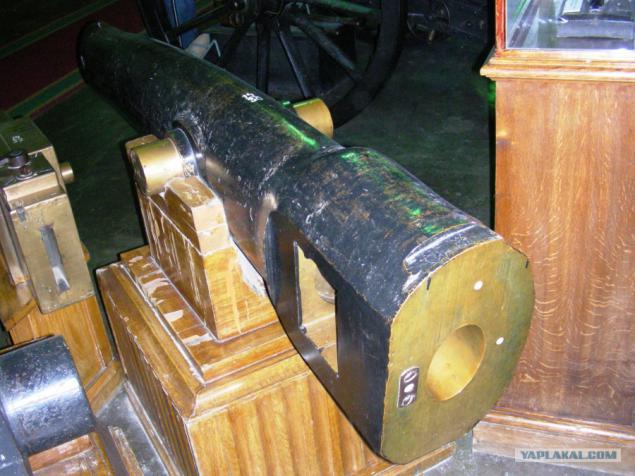
In the second gun, AI systems Plestsova and IV Myasoedova, proposed spinning projectile with a rack in the upper part of the barrel.

At the end of the projectile disk strengthened lead belt that engages with a rack attached to the stem disc desired rotational movement. Test this gun is no information I found.
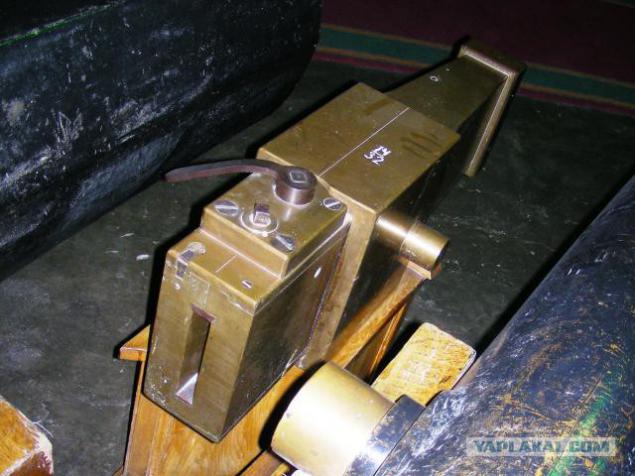
In the third gun, the system AA Andrianov, instead of the rack to use direct rifling: narrow at the top of the bore and wider - at the bottom, so that the projectile at the top of the bore retarding.

It should be noted that all three guns breech-loading, equipped with wedges, cast in bronze.
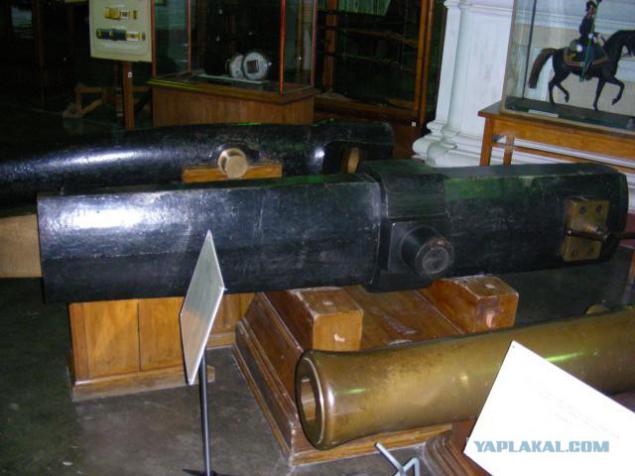
On this photo you can see the muzzle of the three guns.
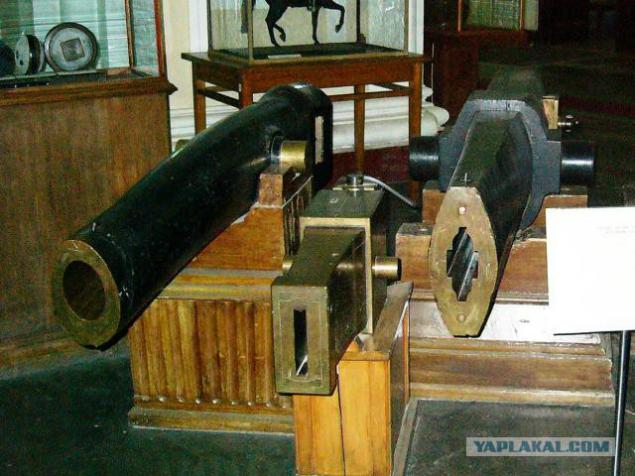
Shells on these systems.

In addition to these systems diskometov, and offers even more, not less orgininalnye example, the same P. Saint Roberto. One of them produced by the British. To give the projectile spin, it was used Bolt below the barrel and muzzle had a small ledge above, further tighten up the drive.
Testing of these systems have shown that the range of rotating disks was even higher than the firing range of conventional ammunition in a vacuum. In addition, if you change the direction of rotation of the projectile, then with a sharp decrease in the firing range of an interesting effect called tylnoboynoy shooting. That is a projectile capable flown through the obstacle to change direction to the contrary, like a boomerang.
Why are these systems were artillery curiosity, not only oust rifled guns, but generally with the test sites at once to send to museums?
The fact is that, along with increased range, gun-diskomety showed exceptionally large expansion on the firing range. Their accuracy was quite poor, and this was due to errors of calculation or not technological flaws in the production, and the very principle on which to base their application. The rotational speed of flattened shells depend on dynamic conditions (frictional force), which vary depending on the driving conditions and not on the design geometry beforehand due to reasons. The flight path of disks is strongly dependent on the atmospheric conditions.
In addition, the capacity of the shells was small, resulting in discontinuous action they were weaker than the ball. Not to mention the fact that the use of percussion fuzes on this type of shells was impossible, and distance - difficult.
Shortly after making these guns began winning streak rifled artillery, which was able to solve the challenges facing the gunners. After that, the Magnus effect they recollected only to amend shooting crosswind that deviate the trajectory of a projectile up or down.
Posted in [mergetime] 1403610318 [/ mergetime]
missed the link to the article in the art of youth referred to the beginning of the post - Fixes.
DISKOMETY
That's it, you can break
12 photo.

Writes aeromamont
About discs.
I have long wanted to write about these exhibits of the Museum of Artillery in St. Petersburg. On the one hand, they pay attention to almost all visitors to the museum, it was too pretentious they look. On the other hand, the information dedicated to these systems are not very plentiful, exhausted explanatory plaque and posters in the museum. I also wanted to talk about in more detail as the original artillery artifacts.

To my surprise, the search for information on the Internet that gave little. Almost everything that was possible to find, was reduced to an explanatory label in the museum, in the best case, repeating its volume. The second source of information for online publications served as a series of articles of prof. Malikov VG dedicated to the history of artillery, were published in the 80s in "Technique of youth." There was a separate article devoted diskometam where in accessible form briefly describes these devices.
Find out something more detail is extremely difficult. All that is in the network is usually limited to these two sources. But I have never found the answer to the question, why did invent such exotica, if you could just take a gun with a rifled barrel, had already long been known.
So I began to dig further. I want to share the results with you in this post.
By the middle of the XIX century smoothbore artillery reached the limit of their capabilities. Further increase mobility, rate, range and accuracy of guns was possible only after a qualitative leap of technology. One such breakthrough was the transition to a rifled barrel. Now it is a truism, but the gunners of the time it was not so obvious. The fact that the first rifled cannon, despite the increase in shooting accuracy and range have numerous disadvantages and for the aggregate characteristics often been unsatisfactory.
First of all, the cost and complexity of manufacturing rifled barrels significantly higher than smooth. A persistence of these trunks, by contrast, declined sharply. The first rifled barrels produced by upgrading smoothbore, by applying the rifling in the barrel.
It quickly became clear that the cast for making rifled barrels is not suitable (insufficient strength at increased pressure of powder gases in the barrel compared to the guns of) and basically reworking touched bronze cannon. However, during the operation revealed the shortcomings of such modernization. Rifling, made in bronze gun barrel, quickly fade under the influence of propellant gases and friction forces. As a result of the upgraded guns again turned into shotguns, but slightly larger caliber, which in turn led to a decrease in the wall of the barrel and, as a consequence, to reduce the strength of the gun. For these reasons, in the end, had to abandon it would seem a promising way of modernizing obsolete guns.
In addition, the instruments remained dulnozaryadnymi and rifled guns firing rate rather decreased. Shells shells for these guns were equipped with lugs. That such:

These protrusions when charging is combined with rifling and scored projectile into the barrel. Between the projectile and the walls of the bore is a gap, leading to a breakthrough propellant gases during firing, which reduced its capacity. In addition, due to these gaps, the projectile got oscillatory motion of a random nature, which reduces the accuracy of fire, nullifying the benefits of rifles. Not to mention the fact that the case of jamming of shells in the barrel during firing.
Offers another polygonal system. Englishman Whitworth, for example, offered to make the bore in the form of a twisted hexagon projectile was a twisted pyramid. Accuracy and range by testing impressive. Equally impressive artillery intricate method of loading a gun. You could show off at the landfill, gently inserting a polygonal projectile in the gun barrel, but in combat such acrobatics was hardly possible. The cost and complexity of such systems is also not allowed to impress customers.
It is necessary to add to the shortcomings of rifled guns of the time small relative length of the barrel.
As we see, in itself rifled barrel while still possessed overwhelming advantages over smooth. Only when there were steel barrel with rifling progressive slope, reliable closures guns, ammunition belts with guides, new gunpowder committed carriages, artillery really moved to a qualitatively new level, poistene becoming the god of war.
But before this was still far off. The way for further development of artillery torili in many different directions. In these conditions, and some appeared guns, shooting discoid shells. They were preceded by the use of so-called regulated shells in conventional smoothbore gun.
In the first half of XIX century. leading countries engaged in yet another improvement of their artillery, widely cycling theoretical research of internal and external ballistics. On this subject there is a good article by Poddubniy, a piece that let me quote:
Thus was established the inevitable deviations from the calculated trajectory of the nucleus, which arises as a consequence of uneven friction kernel of the wall of the bore and the eccentricity of his own. As a result, core, leaving the bore, acquire rotation in a random direction. And though, of course rotation of the nucleus gave it stability in flight, unpredictability rotation direction leads to the practical impossibility of determining the actual trajectory of the projectile.
Remove core eccentricity due to technological difficulties it was impossible. Then the German physicist Magnus in 1852 offered to pay one of the drawbacks of the nuclei in their favor. In his writings, he found that on a body rotating around its flow of gas or liquid, acting shear force in the direction where the peripheral speed of the body and the linear flow are the same. And if so, why not make a kernel with more eccentric and predetermined direction of rotation in the desired direction, and thereby improve the accuracy of the calculated trajectory and its flight range.
At the suggestion was made Magnus party spherical garnet with significant eccentricity. To determine the "light" pole, they were placed in a bath with mercury and by the forces of gravity, the "light" pole turned out above. Next to the "easy" pole smeared with a special mark.
Conducted by experienced such firing grenades showed the correctness of theoretical calculations of Magnus. When loading of the gun "easy" pole down grenade after getting the shot rotation from the bottom up and firing range increased to 1300 meters. And in the reverse position grenades - "light" side up, garnet obtained by rotating the top down and fell to the firing range of 500 meters.
But despite the successful experiments further experiments did not get. The main reason for which were rejected by the gunners shells Magnus became greater complexity loading guns such bombs. It was virtually impossible to properly orient a long barrel guns dulnozaryadnyh. In view of these circumstances gunners turned their attention to the flattened and disk-shaped projectiles.
A. Nilus wrote in his "History of the artillery materiel":
The result of these experiments was the adoption of regulated grenades only in Prussia and Saxony.
Successful results when shooting regulate grenades could happen in Prussia, thanks to the excellent training and discipline of the Prussian gunner and generally careful and judicious his duties by all ranks of the Prussian artillery.
They are unlikely, however, could be preserved in the actual field battle. The use of eccentric regulated grenades and bombs to the firing of mortars and howitzers soon possible in the siege and land war, where the servants closed from serfdom fire. In the field, at the slightest confusion workers, the results of firing grenades regulate may be worse than unregulated. These considerations have prevented the spread of fire grenades regulate other artillery.
And here is one more step remains before suggests solutions. To use the above Magnus and not to suffer with the orientation of the round nucleus in the gun barrel, you need to make the projectile flattened laterally, and make him twist in the barrel from the bottom up with the shot. Then no need to search for "black light", and the axis of rotation of the projectile is always oriented correctly.
One of the first to hit upon the idea of Russian artillery captain AA Shlipenbah Belgian artillery Pyuyt Englishman Vulkomb. They offered Banded shells with holes for eccentricity. The main advantage of these shells they have seen an increase in the lateral load and high breakdown strength projectiles especially on armored warships, then just appeared.
I want to emphasize this detail - primarily interested in the increase of their armor-piercing projectiles compared with round nuclei. Originally this problem have tried to solve by simply increasing the caliber of guns, but it led to an unacceptable increase in the weight of the guns themselves. And here was an attempt to solve the problem elegantly.
However, these shells are disadvantageous all eccentric shells.
Correct these deficiencies were designed to study St. Paul Roberto, published in 1857, which describes the ways in which flattened shells can get the correct rotation. Some of these methods have been implemented and Russian inventors, and the result can be seen on the first photo.
Methods of these are illustrated in the poster, established alongside these instruments in the museum

The top figure shows a poster of weapon prof. Maievsky NV, he proposed in 1868

This instrument is manufactured with curved upward bore. Moving along such a channel trunk disc by centrifugal force is pressed against the top thereof, and thus acquire the necessary rotation. Experienced fire in the years 1871-1873 confirmed the correctness of the calculations: disc projectile weighing 3 to 5 kg with a muzzle velocity of 480 m / s, flying 2,500 meters, while the normal kernel of the same weight under the same conditions - only 500 m. < br />

In the second gun, AI systems Plestsova and IV Myasoedova, proposed spinning projectile with a rack in the upper part of the barrel.

At the end of the projectile disk strengthened lead belt that engages with a rack attached to the stem disc desired rotational movement. Test this gun is no information I found.

In the third gun, the system AA Andrianov, instead of the rack to use direct rifling: narrow at the top of the bore and wider - at the bottom, so that the projectile at the top of the bore retarding.

It should be noted that all three guns breech-loading, equipped with wedges, cast in bronze.

On this photo you can see the muzzle of the three guns.

Shells on these systems.

In addition to these systems diskometov, and offers even more, not less orgininalnye example, the same P. Saint Roberto. One of them produced by the British. To give the projectile spin, it was used Bolt below the barrel and muzzle had a small ledge above, further tighten up the drive.
Testing of these systems have shown that the range of rotating disks was even higher than the firing range of conventional ammunition in a vacuum. In addition, if you change the direction of rotation of the projectile, then with a sharp decrease in the firing range of an interesting effect called tylnoboynoy shooting. That is a projectile capable flown through the obstacle to change direction to the contrary, like a boomerang.
Why are these systems were artillery curiosity, not only oust rifled guns, but generally with the test sites at once to send to museums?
The fact is that, along with increased range, gun-diskomety showed exceptionally large expansion on the firing range. Their accuracy was quite poor, and this was due to errors of calculation or not technological flaws in the production, and the very principle on which to base their application. The rotational speed of flattened shells depend on dynamic conditions (frictional force), which vary depending on the driving conditions and not on the design geometry beforehand due to reasons. The flight path of disks is strongly dependent on the atmospheric conditions.
In addition, the capacity of the shells was small, resulting in discontinuous action they were weaker than the ball. Not to mention the fact that the use of percussion fuzes on this type of shells was impossible, and distance - difficult.
Shortly after making these guns began winning streak rifled artillery, which was able to solve the challenges facing the gunners. After that, the Magnus effect they recollected only to amend shooting crosswind that deviate the trajectory of a projectile up or down.
Posted in [mergetime] 1403610318 [/ mergetime]
missed the link to the article in the art of youth referred to the beginning of the post - Fixes.
DISKOMETY
That's it, you can break
